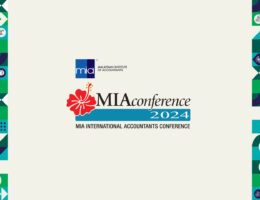To raise the competency of accountancy professionals in commerce and industry, who make up about 65% of MIA membership, the Institute has embarked on a comprehensive and integrated strategy to future-proof chief financial officers (CFOs) and the finance function.
Key to this is to bridge competency gaps in compliance with financial regulations and accountancy standards, as well as competency gaps in strategy, leadership and communications of the finance function and the CFO as the leader of the finance function.
Competency Frameworks
To help upskill professional accountants in business (PAIBs), MIA launched its Competency Framework for Finance Function in Public Interest Entities (PIEs) in June 2019 at the CFO Conference 2019, which complements the Competency Framework for Chief Financial Officers (CFOs) in PIEs launched a year earlier in June 2018.
These two frameworks are pivotal to MIA’s initiatives to future proof CFOs and the finance function and improve their relevance and value as the business and regulatory landscape becomes more complex, said Simon Tay, MIA Executive Director, Professional Practices and Technical.
In his presentation entitled “In a Nutshell: Competency Framework for CFOs and Finance Functions in PIEs”, Tay explained that the two Frameworks were issued following extensive research and engagement with stakeholders, namely through focus group discussions and roundtables. Tay said that the MIA PAIB Committee with its diverse representatives as well as the MIA working groups were essential to the creation of these competency frameworks and their ongoing dissemination and implementation.
Finance function transformation will enhance businesses by upskilling PAIBs with the core competencies required of finance professionals working in the era of Industrial Revolution 4.0 (IR4.0):
- One, competency in the preparation of financial statements and external reporting in compliance with accounting standards and relevant laws and regulations. Feedback from regulators indicates that there is room for improvement in the matter of compliance, said Tay.
- Two, competency in financial management, strategy development and execution, and communications with stakeholders. “The CFO is no longer a backroom person but a leader, business partner and trusted moral compass. The CFO should develop a business and strategic mindset, be an independent voice to challenge decisions and have the agility to adapt to changes. As others have said, the CFO should think like the CEO but act like the CFO,” said Tay.
“The Competency Framework for CFOs was launched first because we realised that the leader of the finance function is very important. Make sure that the leader is right then everything will follow thereafter,” said Tay.
“The continuation with the Competency Framework for Finance Functions is a natural progression and will assist the CFO in carrying out the roles as mentioned in the Competency Framework for CFOs.”
Competency Framework for CFOs in PIEs
In summary, this Framework guides organisations and finance professionals on the expectations and roles of CFOs today and includes recommendations for upskilling CFOs.
Tay enumerated the expectations of the person of the CFO today, according to the 5 key principles by the International Federation of Accountants (IFAC):
- Be an effective organisational leader and a key member of senior management
- Balance the responsibilities of stewardship with business partnership
- Act as the integrator and navigator of the organisation
- Be an effective leader of the finance and accounting function
- Bring professional qualities to the role and the organisation.
Competent CFOs are expected to fulfil the following core roles according research by Ernst & Young (EY):
- Ensuring business decisions are grounded in sound financial criteria
- Providing insight and analysis to support CEO and other senior managers
- Leading key initiatives in finance that support overall strategic goals
- Leading key funding , enabling and executing strategy set by the CEO
- Developing and defining the overall strategy for the organisation
- Representing the organisation’s progress on strategic goals to external stakeholders.
Following the launch of the Competency Framework for CFOs, MIA is actively creating awareness and educating CFOs and Boards on the Framework, while supporting implementation of the Framework’s recommendations, which are:
- Advocating the Competency Framework as a reference guide for companies, Audit Committees and CFOs in defining the CFO’s roles and deliverables.
- Delivering innovative continuing education for CFOs. MIA has designed integrated and strategic development programmes and initiatives to future-proof CFOs, including the CFO Conference franchise and other targeted professional development and learning programmes, the high-level CFO Circle networking platform and the Competency Frameworks.
- Recommending a minimum of 20 credit hours of structured and verifiable CPD learning for each calendar year.
- That only a competent person be appointed as the CFO of a PIE.
Tay noted that some organisations had already begun applying the Competency Framework for CFOs in PIEs to enhance the quality of their CFO and finance function. Feedback so far indicates that companies find the Framework useful as a guide for finance and business transformation.
Competency Framework for Finance Functions in PIEs
A competent finance function is vital to support the CFO as the leader of the finance function.
In today’s complex business landscape, finance functions are expected to do more than report the numbers. To support the CFO as he discharges the six roles defined above, the finance function too needs to go beyond financial management into the domains of strategy and business partnership.
Nevertheless, the finance function must continue to act as financial stewards, particularly on financial management and regulatory compliance. This must be supported by professionalism and a high standard of ethical behaviour that is “cascaded down from the CFO to the entire finance function,” said Tay, as well as the implementation of controls to manage risk and pre-empt financial mismanagement.
According to the Framework, the finance function should be able to:
- Strengthen strategy alignment, business planning, performance reporting and analytical capabilities
- Empower the organisation to make better and more informed decisions based on the right information delivered at the right time
- Transform data into intelligence that enables actionable insights and decisions that highlight key performance measures
- Leverage the latest information technologies development to take advantage of evolving market opportunities
- Function as an effective check and balance on operations (through proper controls) and as a gatekeeper to uphold good governance (through demonstration of professionalism and ethical behaviour).
The Framework recommends three tools to measure the effectiveness of the finance function and target improvements.
Tool 1: Finance Assessment Framework by PwC, which assesses the finance function’s performance on the three key measures of business insights, compliance and control, and efficiency.
Tool 2: Finance Target Operating Model by KPMG which shows where the finance function is on a scale from low-performing to high-performing. “This shows the ideal finance function with six areas to consider – the organisation, services, location, people, technology and processes,” said Tay.
Suboptimal finance functions behave in the following way: they are in silos, entirely internally focused, have decentralised processes which are inefficient, their people are scorekeepers, systems and data models are incompatible and their processes are business unit specific.
On the other hand, the ideal finance function is integrated, drives value, optimises shared services and strategic sourcing, is a business partner, uses centralised data models and systems that are effective and efficient, and is standardised and optimised.
Tool 3: Indicators and Red Flags Diagnostics Analysis enable comparison with a checklist of indicators or red flags that can be used to pinpoint weaknesses or potential problems affecting the finance function.
The Competency Framework lists potential red flags in:
Financial Reporting – significant deviation in unaudited and audit net profit, late closing of financial statements, significant adjustments/amendments between first draft and audit financial statements, incomplete disclosures in draft before audit, lack of insight shared with management arising from analysing operational results, evidence of window dressing and other forms of creative accounting. non-compliance with Bursa listing requirements and other regulations, scrutiny of policies and disclosures by regulators, etc.
Compliance and control – reconciliations are not conducted frequently, significant internal control weaknesses detected and unaddressed, late audit confirmation replies, occurrence of material fraud staff competencies not developed, technology for systemic efficiency not adopted etc.
Behavioural – high staff turnover and no succession planning.
Stakeholder Management – no profit warning before an incident happens, lack of use of analytics for effective assessment purposes, inability to support the Board and CEO to manage the numbers.
Moving forward, the onus will be on advocacy and implementation to drive the transformation of the finance function, in order to support better business performance and good governance.
Tay noted that there will be challenges. One, there is a need to convince the Boards to invest in CFO and finance function transformation. MIA will advocate for transformation by engaging and educating Boards, especially Board Audit Committees, to apprise them of the importance of having a fit-for-purpose finance function. Two, CFOs themselves must take the initiative to formulate a plan that details competency gaps within the finance function and how to address them and obtain Board buy-in for their plan.






